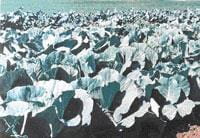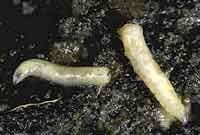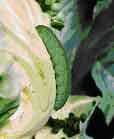
Saskatchewan's climate and soils are well suited for growing cabbage (Brassica oleracea). Cabbage, like canola, mustard, rutabaga, broccoli, cauliflower and Brussels sprouts, is a cole crop and a member of the Brassicaceae family.
Due to our large canola acreage, cabbage has many insect pests in Saskatchewan.
Soil Conditions
Cabbage is a shallow rooted plant, and deep tillage is not required.
There are other considerations including:
- The soil does need to be worked well, with no clods or rocks.
- Well-drained soils with high organic matter content are preferred.
- Crop rotation out of a cruciferous crop is needed to avoid persistent disease problems.
- Do not plant into soil that is known to be infested with clubroot.
- Avoid planting conditions that promote soil crusting, which will interfere with plant emergence and lead to uneven stands.
Seed Treatment
Hybrid varieties produce more uniform plants than open pollinated heritage varieties.
Due to the seed's higher value, it is best to use treated seed, to prevent:
- Seedling blight;
- Damping off; and
- Seed decay.
Hot water treatment of the seed is effective against alternaria, black rot and blackleg. This treatment can be specially done by your seed company, but must be done prior to seed coating.
Types
There are four main types of cabbage:
- Early: are seeded or transplanted as early as possible in the spring, allowing them to be harvested early in the summer. They head-out quickly, traditionally have smaller loose heads and mature in 50 to 60 days from when they were transplanted. They typically have a low dry matter content and poor storage potential.
- Mid-season: these cabbages will form medium-sized heads, and mature in 90 to 95 days. Mid-season cabbages can either be direct-seeded or transplanted.
- Late-season: will form the largest and densest heads, and also require a longer growing season. It may take up to 130 days for a late-season cabbage to mature. They are also referred to as storage cabbages.
- Red: are very attractive for use in salads. Red cabbage is typically a longer season cabbage with good storage potential.
The University of Saskatchewan Plant Sciences Department maintains a database of varieties that have been tested and provides recommendations for varieties that perform well.
Seeding
Direct-seeded cabbage is usually planted in early to mid-May. Direct-seeded cabbages are planted 5 to 8 cm (2 to 3 inches) apart (1.1 kg/ha or 1 lb/ac) and thinned later.
Seeding rate recommendations for transplanted cabbage vary with time of planting.
Early-season:
- In-row spacing - 25 to 46 cm apart (10 to 18 inches) apart
- Between-row spacing - 0.76 m (2.5 feet) apart
Mid-season:
- In-row spacing - 30 to 46 cm (12 to 18 inches) apart
- Between-row spacing - 0.7 to 0.9 m (2 ½ to 3 feet) apart
Late-season:
- In-row spacing - 46 to 61 cm (18 to 24 inches) apart
- Between-row spacing - 0.7 to 0.9 m (2 ½ to 3 feet) apart
Row spacing will be dependent on your tillage, planting and harvesting equipment.
Many cabbage growers in Saskatchewan use transplants to:
- Reduce seed costs;
- Accelerate crop development;
- Increase yields;
- Overcome problems with cruciferous flea beetles destroying emerging seedlings;
- Eliminate costs associated with thinning the direct-seeded crop; and
- Avoid soil crusting problems in clay soils.
In warm, dry springs flea beetle populations are high enough that flea beetles are already present on the crop as it emerges. Damage at emergence injures the growing tip, causing bolting, misshapen heads or death.
Growers who transplant have the option of planting and then following behind with an insecticide treatment to kill the flea beetles before any damage can occur.
The same can and is done for direct-seeded cabbage, but the grower must be more vigilant and closely watch for seedling emergence. They can then make a pass with an insecticide. A seed row treatment can be applied during planting to control cruciferous flea beetles.
Fertility
Always start any fertility program with a soil test. Random samples should be collected from the entire field being planted. Due to climactic conditions, differing cultural practices, varying soil conditions and other situations, the crop's response to a fertility regimen may vary from region to region.
Nitrogen, phosphorus and potassium can either be broadcast and then incorporated, or side-banded. A general rate recommendation would be 60 to 100 kg/ha (54 to 89 lbs/ac) of nitrogen, 150 to 180 kg/ha (133 to 160 lbs/ac) of phosphorus and 170 to 200 kg/ha (152 to 178 lbs/ac) of potassium.
Reduce the phosphorus recommendation to 1/5 if sidebanded and potassium to 1/2 if sidebanded. Nutrient deficient cabbage crops exhibit obvious symptoms of the stress, except for slow growth.
Excessive nitrogen application should be avoided, as it can lead to splitting of the head. Calcium and boron are important nutrients in cabbage production. Additional boron may need to be added to avoid decay and hollowing of the pith (core), and calcium may be needed to avoid tipburn.
Follow the recommendations from your soil test for these nutrients.
Irrigation
Due to their large leaf area, cabbage requires at least an 25 cm (1 inch) of water per week to sustain good growth. Excessive watering late in the season can cause head-splitting. Uneven soil moisture can cause fluctuations in the uptake of nutrients and lead to tipburn or head-splitting. Soil should be kept at 60 to 70 per cent field capacity to ensure good yields and head quality.
The fact that cabbage is a cool season crop indicates that it responds favourably to lower temperatures with adequate amounts of rainfall. Cabbage also requires well-drained soil. Soil that is not well-drained should either have drainage tiles installed or have some organic matter added to it to improve soil aeration.
Harvesting
Cabbage is usually harvested by hand, and the availability of a good labour force is essential. Conveyors placed in front of the pickers are a picking aid and increase the efficiency of the hand harvest. The pickers place their produce on the conveyor and it is conveyed up to a central trailer. Early fresh market cabbage can be picked any time after the heads are mature. Once harvested, the cabbages are immediately taken to the storage for removal of field heat.
When harvesting cabbage, pull back the two or three outer wrapper leaves. Then, with a sharp knife, cut the stem at the base of the cabbage. Be careful when handling cabbage so as to not damage the product. Damaged outer leaves can be removed. This will allow the product to still be marketed, but it reduces the weight of the head.
Storage cabbage should be harvested as late as possible to ensure cabbages are fully mature. Excessive freezing of the cabbage head should be avoided to reduce the need to trim outer leaves. Trimming produces a whiter cabbage since the greener outer leaves have been removed. Most buyers do not like the whiter cabbage heads, so keep this in mind.
For larger operations, there are once-over cabbage harvesters on the market. Damage to the harvested head is one concern with these machines.
Storage
Cabbages stored at 0°C and at 90 to 95 percent relative humidity (1°C for processing cabbages) will last for four to six months depending on the cultivar. Temperatures lower than 0°C will cause freezing damage. Controlled-atmosphere storage units are recommended for cabbages to be stored for a longer period of time.
Controlled-atmosphere storages are unique in that they reduce oxygen levels and increase carbon dioxide levels in an airtight, refrigerated storage environment. This aids in further suppressing metabolic activity in stored cabbage.
Controlled-atmosphere storages will not improve the quality of the product stored, but will maintain the quality for a longer time period. These storage units are costly, normally 20 to 30 per cent higher than a conventional storage unit.
Cabbage will shrink during extended storage, and the outer leaves may shrivel. The outer leaves can be trimmed, increasing weight loss in the stored crop.
Grade-out or cull any heads that are diseased before they enter storage. All cabbages should be clean before going into storage.
Grades
Cabbage can be sold in Canada under the following grades: Canada No. 1 and Canada No. 2.
The following are some of the requirements of cabbages to be a Canada No. 1 grade:
- Differing types of cabbage should not be packed together (i.e. a red packed with a green)
- Produce must be properly packed, meaning that it will not be damaged during handling or transport and the container contains not less than the net quantity that is shown on the label.
- There is no minimum or maximum size for a Canada No. 1 cabbage, but cabbages cannot vary more than 51 mm (two inches) in a pack
- Avoid having dirt or mud smeared on the outer leaves
- Burst or split heads are not allowed in Canada No. 1 bag
- When trimming:
- The butts can be no longer than 12.7 mm (1/2 inch);
- There cannot be more than six wrapper leaves present; and
- All damaged outer leaves must be removed.
For complete grade requirements consult the Canadian Grade Compendium Vol 2 included in the Safe Food for Canadians Act.
Pest Problems
Diseases
Clubroot (Plasmodiophora brassicae) is a soil-borne disease that infects plants though the roots. The roots become deformed and are unable to take up nutrients and water leading to premature death.
Clubroot is regulated through The Pest Control Act, giving rural municipalities the authority to undertake prevention and enforcement measures related to the spread and control of clubroot.
Control measures include:
- Using clean transplants;
- Maintaining soil pH above 7.3;
- Disinfecting all tillage equipment;
- Increasing years between cruciferous crops; and
- Keeping cruciferous weeds under control.
Black rot (Xanthomonas campestris) is characterized by yellowing of the leaves edges that slowly works into the centre of the leaf.
The leaf areas eventually turn brown and dry up. Black rot is introduced on the seed. It is transmitted plant to plant by contact or water splash.
Control measures include:
- Buying seed that is certified and tested to be disease-free;
- Treating your seeds with hot water 50°C (122° F) for 25 minutes when purchasing to ensure they are disease-free; and
- Having at least a three-year rotation between cruciferous crops.
Black rot is a very serious problem in greenhouses. Controls include watering from the bottom of trays and the use of copper based foliar sprays.
Blackleg (Phoma lingam) This fungal disease is active at low temperatures.
Symptoms include seedling death or bluish growth on the stems of older plants near the base. Upon germination, infected seedlings are covered by lesions that can be spread to adjacent plants by rainfall or irrigation.
Control measures include:
- Hot water treatment (see Black rot);
- Eradication of cruciferous weeds; and
- An at least a three-year crop rotation with other non-cruciferous crops.
Downy Mildew (Peronospora parasitica) is a fungus that over-winters in perennial plants and infected plant debris.
Symptoms include a tan paper-like appearance that continues to develop into larger, sunken areas on the head.
Control measures include:
- A three-year crop rotation with non-cruciferous crops; and
- Preventative applications a registered fungicide.
Insects

Cruciferous flea beetles (Phyllotreta cruciferae) are small black beetles that attack cabbages throughout the growing season. They are especially dangerous in the spring when seedlings are emerging.
The large acreage of canola in Saskatchewan ensures that there will always be a sizable population of flea beetles in the province. Flea beetles feeding on emerging cabbage crops cause seedling death, uneven growth and maturity. Flea beetles have one generation per year, but the adults appear twice, once early in the spring and again later in the fall.
Control measures include:
- Crop rotations of more than three years with non-cruciferous crop;
- Eliminating cruciferous weeds; and
- Not planting near fields that have cruciferous crops.
There are numerous pesticides registered to control flea beetles in cabbage.

University of California Photo by
Jack Kelly Clark
Cabbage Maggot (Delia radicum) is an underground pest that feeds on the roots of the host plants. The survival rate of the eggs is highest when the weather is cool and moist, much like spring conditions.
Cabbage maggots can severely stunt growth or kill seedlings and can lower quality and reduce yields of more mature plants.
The maggot is the larval stage of the cabbage maggot fly, which looks much like a common housefly. The lifecycle has two generations per season.
Control measures include:
- A crop rotation of three or more years away from cruciferous crops;
- Eradication of cruciferous weeds; and
- Chemical control for cabbage maggots with an insecticide placed near the seed at planting.

larvae (Photo courtesy of Clemson University
Entomology Department)
Imported Cabbage Worm and Cabbage Looper (Pieris rapae) and (Tricoplusia ni) are also referred to as the cabbage butterfly.
Imported cabbage worm larvae, which are light green in the larval stage, are incredibly destructive. They chew large holes in the leaves and head of cabbages. Their waste products also contaminate the head.
Control measures include:
- A crop rotation of three or more years away from cruciferous crops;
- Eradication of cruciferous weeds; and
- Chemical control of repeated foliar applications of insecticides.
Diamondback Moth (Plutella xylostella) does not over-winter in Canada, the adult moths fly or blow in each year from the United States.
Larvae chew irregular patterns into the lower leaves. The larvae may also tunnel into the head of the cabbage, hurting its market potential.
Control measures include:
- Monitoring the crop for arrival of adults; and
- Eradicating any cruciferous plants, including weeds and the refuse from early harvests of cruciferous crops.
Weeds
Competition from weeds early in the season will slow both emergence and early growth. Weeds can be controlled with shallow tillage to destroy any weed seedlings. Weeds can also be controlled chemically.
Other Problems

cabbage head (Photo
courtesy of the Asian
Research and Development
Centre)
Head splitting is caused by excessively rapid growth.
This problem can be managed by:
- Ensuring there is adequate organic matter to hold soil moisture;
- Providing consistent even watering;
- Avoiding over-fertilizing with nitrogen; and
- Spacing close and evenly to discourage excess and rapid root growth.
Heads that are cracked should be culled, as they become an entry point for secondary infections such as soft rot.
Tipburn is caused by inadequate amounts of calcium in the youngest region of the plant. Usually, this is due to rapid growth. There are no initial outer symptoms on the cabbage head, but the inner leaves turn brown.
Tipburn:
- Occurs when the translocation of calcium to the growing tip is slowed;
- Can only be controlled by discouraging rapid growth (see head splitting); and
- Is very cultivar specific.
Adding calcium to the soil does not fix this problem.
